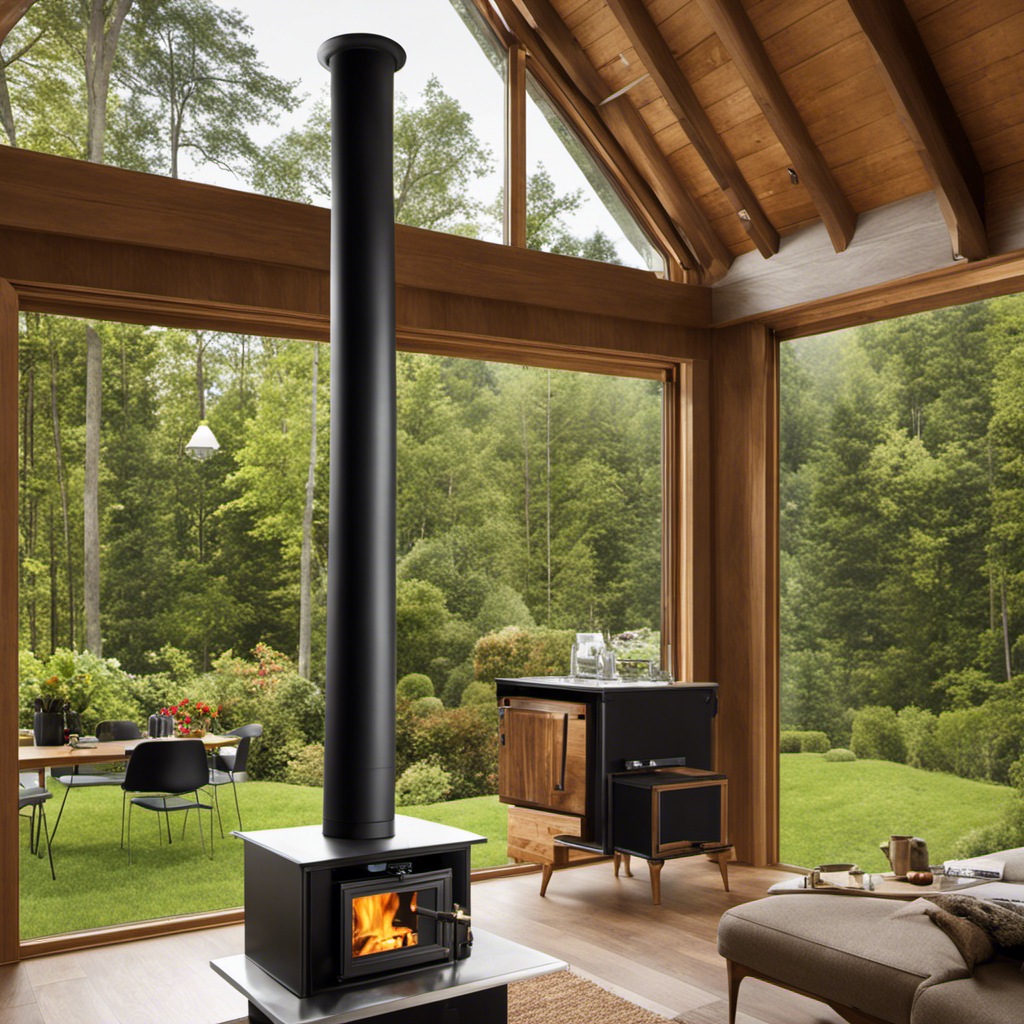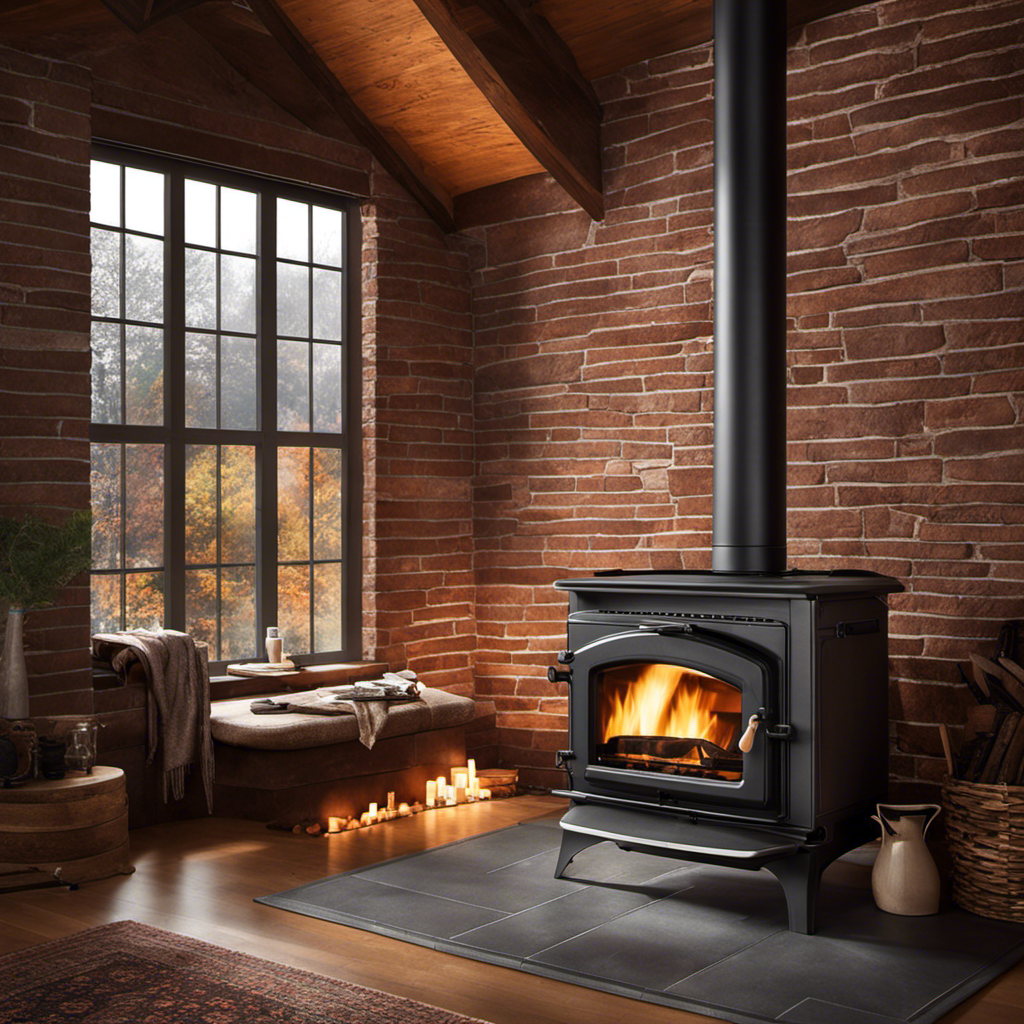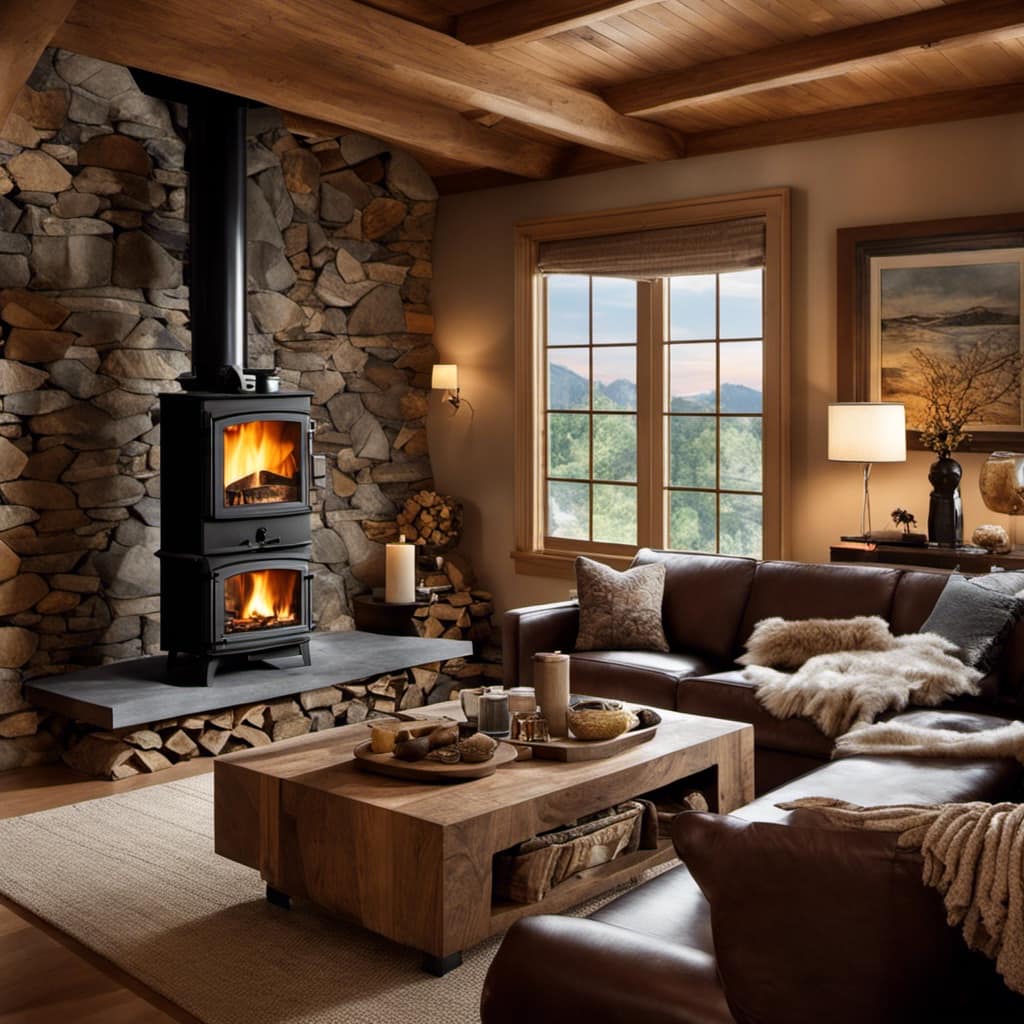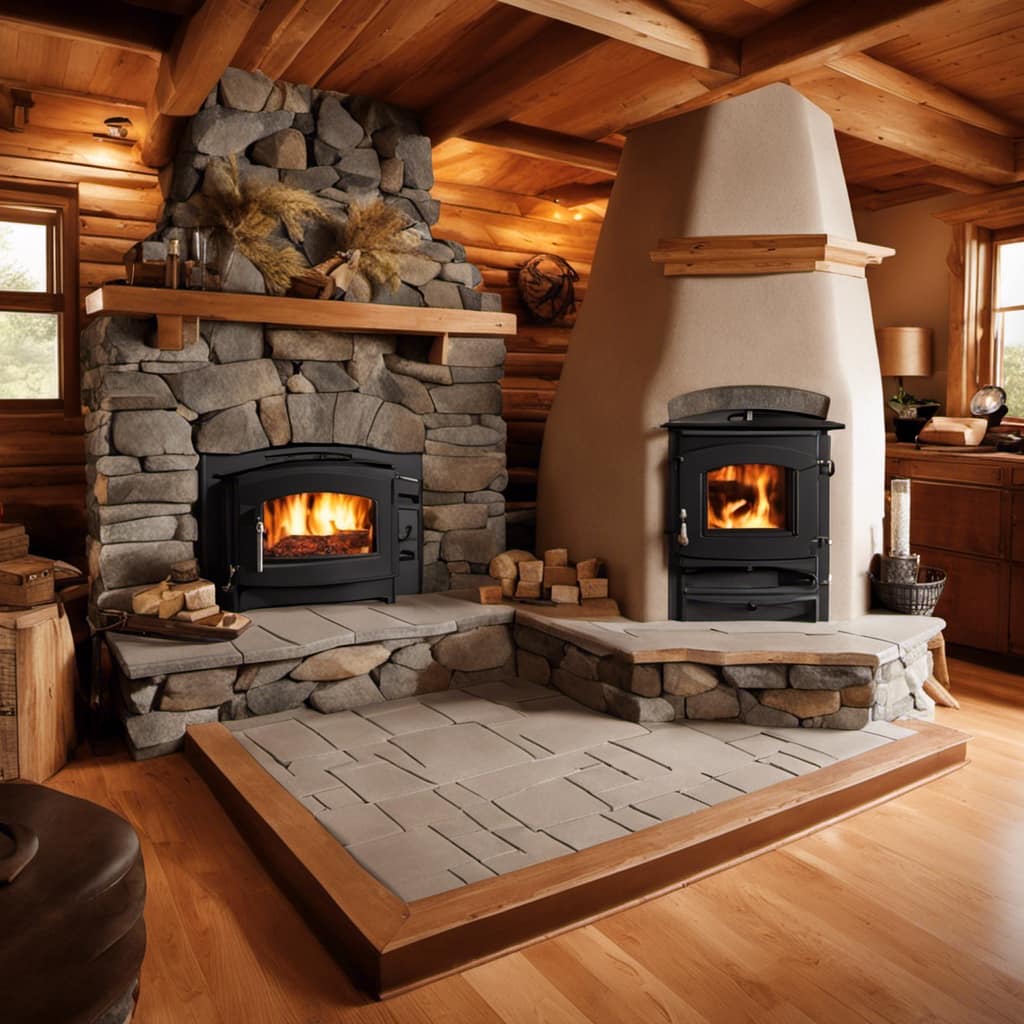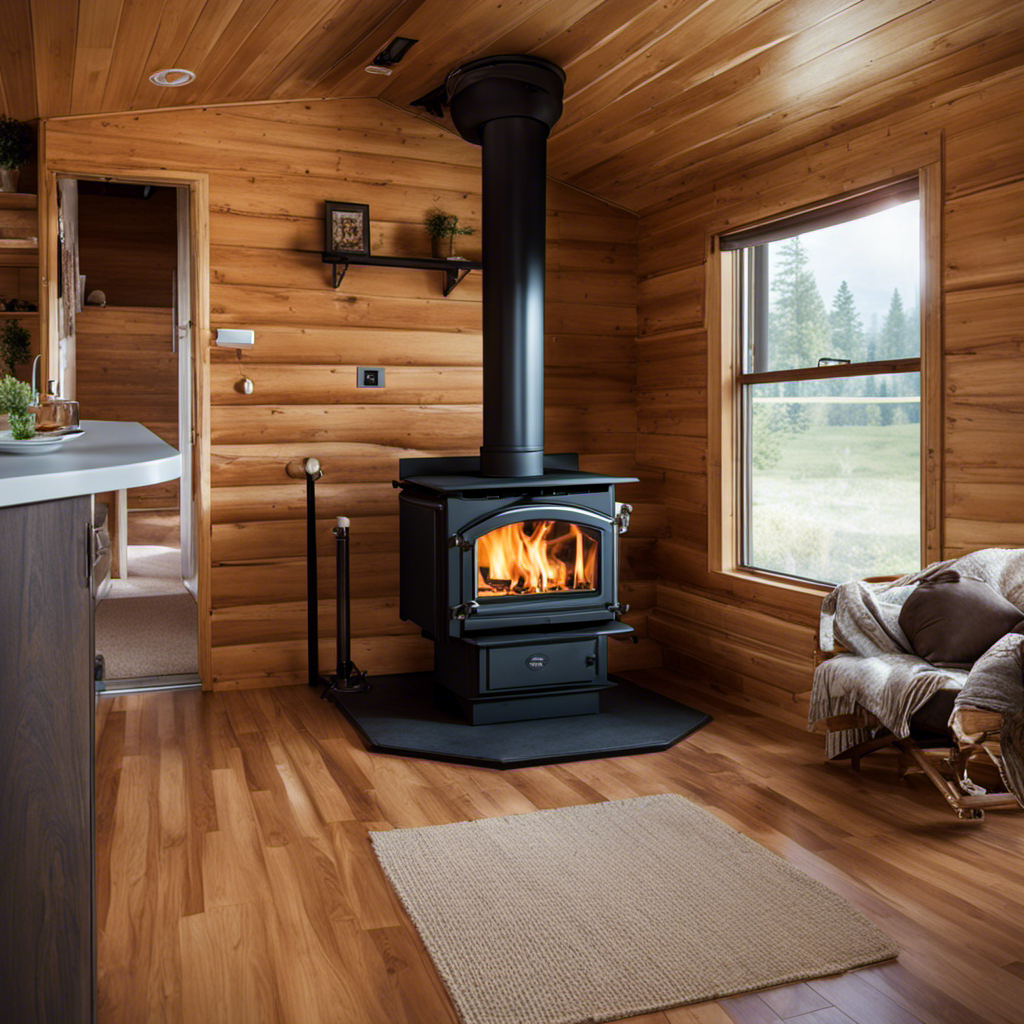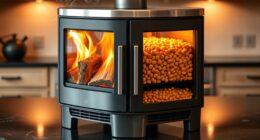I have always had a fascination with the different types of wood stove chimneys available. Did you realize that they generally fall into three main categories: masonry, pre-fabricated metal, and direct vent?
Each type has its own unique features and requirements. In this article, I’ll guide you on how to identify what type of wood stove chimney you have. By understanding your chimney type, you can ensure proper maintenance and safety for your wood stove.
Let’s dive in and explore the world of wood stove chimneys!
Key Takeaways
- Proper identification of the wood stove chimney type is essential for ventilation and preventing hazards.
- Different chimney materials require different maintenance and cleaning techniques.
- Masonry chimneys are made of materials such as brick, stone, concrete, or tile and have their own advantages and considerations.
- Pre-fabricated metal chimneys are commonly made of stainless steel or galvanized steel and require proper installation and maintenance procedures.
The Importance of Identifying Your Wood Stove Chimney Type
I learned the importance of identifying my wood stove chimney type to ensure proper ventilation and prevent potential hazards.
When it comes to identifying different chimney materials, there are a few key things to look for.
Firstly, you need to determine whether your chimney is made of masonry or metal. Masonry chimneys are typically made of brick or stone and are more common in older homes. Metal chimneys, on the other hand, are often made of stainless steel or galvanized steel and are commonly found in newer constructions.
Identifying the material is crucial because each type requires different maintenance and cleaning techniques.
Moreover, understanding the common issues with wood stove chimneys is essential. Some common problems include creosote buildup, chimney blockages, and structural damage.
Understanding Masonry Chimneys for Wood Stoves
I’ve always wondered about the benefits and maintenance requirements of masonry chimneys for wood stoves. Understanding chimney construction is crucial in ensuring the safety and efficiency of your wood stove. There are different types of masonry chimneys, each with its own advantages and considerations. To give you a better understanding, let’s take a look at the following table:
| Chimney Type | Advantages | Considerations |
|---|---|---|
| Brick | Durable and long-lasting | Requires regular maintenance and inspections |
| Stone | Adds aesthetic appeal | Prone to cracking and weathering |
| Concrete | Affordable and versatile | May require reinforcement in high wind areas |
| Tile | Good insulation properties | Vulnerable to moisture damage |
Identifying Pre-Fabricated Metal Chimneys for Wood Stoves
To properly identify pre-fabricated metal chimneys for wood stoves, it’s important to carefully inspect the construction materials and look for any manufacturer labels or markings. Here are some key aspects to consider when determining the type of chimney you have:
-
Construction Materials:
-
Look for stainless steel or galvanized steel construction, as these are commonly used for pre-fabricated metal chimneys.
-
Check for insulation between the inner and outer walls, which helps maintain proper draft and prevents excessive heat transfer to combustible materials.
-
Manufacturer Labels or Markings:
-
Search for any labels or markings on the chimney itself, as they usually provide important information about the chimney’s specifications and installation requirements.
-
These labels may include details such as clearance requirements, maximum temperature ratings, and certification information.
Identifying the installation and maintenance procedures for pre-fabricated metal chimneys is crucial for ensuring their safe operation. Once the chimney type is identified, it’s essential to follow the manufacturer’s guidelines for installation, including proper clearances from combustible materials and the correct height and location for the chimney termination. Additionally, regular maintenance procedures such as cleaning and inspecting the chimney should be carried out to ensure its continued efficiency and safety.
Now that we have a good understanding of identifying pre-fabricated metal chimneys, let’s explore another type of chimney commonly used for wood stoves: direct vent chimneys.
Exploring Direct Vent Chimneys for Wood Stoves
Exploring direct vent chimneys for wood stoves, I’ve found that they offer a more efficient and safer option for venting smoke and gases out of the home. Unlike traditional chimneys, direct vent chimneys utilize a sealed combustion system that draws outside air for combustion and expels the byproducts outdoors. This eliminates the need for a traditional chimney, as the direct vent chimney can be installed through a wall or roof.
One of the key benefits of direct vent installation is improved energy efficiency. By drawing in outside air for combustion, direct vent chimneys minimize the amount of indoor air that is used, reducing heat loss and increasing the stove’s overall efficiency. Additionally, direct vent chimneys offer enhanced safety by preventing the backflow of combustion gases into the home.
In terms of aesthetics, direct vent chimneys also provide more flexibility in terms of placement and design. They can be installed in various locations within the home, allowing for more creative and functional stove placement.
To summarize, direct vent chimneys for wood stoves offer improved efficiency, safety, and design flexibility compared to traditional chimneys.
| Benefits of Direct Vent Chimneys |
|---|
| Enhanced energy efficiency |
| Improved safety |
| Greater design flexibility |
| Eliminates the need for a traditional chimney |
| Can be installed in various locations within the home |
Does the Type of Chimney I Have Affect the EPA Certification of My Wood Stove?
Yes, the type of chimney you have can affect the wood stove EPA certification. It must be compatible with the stove and meet specific requirements to ensure safe and efficient operation. A properly installed and approved chimney is essential for achieving compliance with wood stove EPA certification standards.
How Can I Determine if My Wood Stove Chimney is Properly Listed?
When checking if your wood stove chimney is properly listed, look for specific wood stove listing meanings on the chimney and stove. The listing indicates that the product has undergone testing and meets safety standards. Ensure that the chimney and stove have the appropriate listing to guarantee their safety and performance.
Tips for Determining Your Wood Stove Chimney Type
While researching wood stove chimney types, I’ve discovered that determining the correct type is crucial for ensuring proper installation and efficient operation.
Here are some tips for inspecting chimneys and identifying common chimney problems:
-
Look for signs of creosote buildup, such as black, tar-like substance on the chimney walls.
-
Check for any cracks or gaps in the chimney structure, as this can lead to leaks and potential fire hazards.
-
Pay attention to the color of the chimney smoke. White or light gray smoke indicates a well-functioning chimney, while dark or black smoke may indicate a problem.
-
Inspect the chimney cap for any damage or obstructions, as this can affect the draft and prevent proper ventilation.
-
Check for any loose or deteriorating bricks or mortar, as this can compromise the structural integrity of the chimney.
Frequently Asked Questions
How Do I Know if My Wood Stove Chimney Is in Good Condition?
To know if my wood stove chimney is in good condition, I look for signs of chimney damage, such as cracks, leaks, or blockages. I inspect it regularly, cleaning the flue and ensuring proper ventilation for safe and efficient operation.
Can I Use a Masonry Chimney for a Wood Stove if It’s Not Specifically Designed for It?
Yes, you can use a masonry chimney for a wood stove, even if it’s not specifically designed for it. However, it’s crucial to ensure the chimney is compatible with wood stove use to prevent any safety hazards.
Are There Any Specific Regulations or Codes That I Need to Follow When Installing a Pre-Fabricated Metal Chimney for a Wood Stove?
When installing a pre-fabricated metal chimney for a wood stove, it’s important to follow regulations and codes to ensure safety. Precautions include proper clearance, proper installation, and regular maintenance. Avoid common mistakes like improper sizing and inadequate insulation.
Can a Direct Vent Chimney Be Used for Any Type of Wood Stove, or Are There Specific Models That Are Compatible?
Yes, a direct vent chimney can be used with specific wood stove models. It offers pros like increased efficiency and flexibility in installation. However, traditional chimneys have their own benefits. It’s important to choose the right chimney for your wood stove.
Are There Any Maintenance or Cleaning Requirements for Different Types of Wood Stove Chimneys?
Cleaning requirements for different types of wood stove chimneys vary, but regular maintenance is essential. Inspecting for creosote buildup, cleaning or replacing chimney caps, and ensuring proper airflow are important maintenance tips to prevent chimney fires and maintain optimal stove performance.
Conclusion
In conclusion, identifying the type of wood stove chimney you have is crucial for ensuring proper installation and safety. By understanding the differences between masonry, pre-fabricated metal, and direct vent chimneys, you can make informed decisions about maintenance and upgrades.
Remember the adage, ‘Knowledge is power,’ as it reminds us that being well-informed empowers us to make the best choices for our wood stove and chimney system.
Stay knowledgeable and enjoy the warmth and comfort of your wood stove safely.
Logan’s affair with adventure began in childhood. He hailed from a small town where vast forests bordered one side and endless shores stretched on the other. His days were spent exploring uncharted woods, climbing tall trees, or listening to the tales of old sailors. This early immersion in a world brimming with stories and mysteries became the foundation of his passion for writing.

